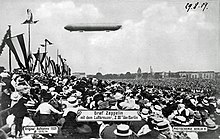LZ 6
The Zeppelin LZ 6 (also called Luftkreuzer Z III in contemporary texts ) was a commercial airship owned by the Deutsche Luftschiffahrts-Aktiengesellschaft ( DELAG ) at the beginning of the 20th century.
history
LZ 6 was a further development of the previous zeppelins. The new airship made its maiden voyage on August 25, 1909. From August 27 to 29, 1909, the LZ 6 embarked on the Kaiserfahrt to Berlin; the first trip of a zeppelin to Berlin. This was followed by a visit to the International Airship Exhibition in Frankfurt . LZ 6 has been converted for use as a passenger airship since February 12, 1910. A third motor of 140 hp was used and a passenger cabin in the shape of a railroad car for around 20 passengers was suspended between the front and rear machine gondolas. After 39 trips, LZ 6 was sold to the DELAG aviation company to operate passenger air traffic.
DELAG made tours in the Zeppelin over the area around Baden-Baden, to Strasbourg and Karlsruhe. DELAG undertook 34 passenger and mail transport trips with LZ 6.
LZ 6 made the first attempts with radio from an airship.
The captains of LZ 6 were Hugo Eckener , Ludwig Dürr and Georg Hacker .
End of LZ 6
Due to the negligent behavior of the ground crew, the airship burned on September 14, 1910 in its hall in Baden-Oos in the Black Forest. After a sightseeing flight, LZ 6 was brought in for repairs. A fitter cleaned an engine against the instructions with white spirit and then started it for a test run. The gasoline-air mixture ignited. The open petrol can caught fire, so that soon not only the gondola but also the outer shell of the airship was on fire. The gas cells also caught fire, but as luck in misfortune, the escaping gas only flared outside above the hall. After ten minutes all that was left was the aluminum frame with the gondolas and a few scraps of cloth. Two people were slightly injured.
Technical data before the conversion
- Carrying gas volume: 15,000 m³ hydrogen
- Length: 136 m
- Diameter: 13.0 m
- Payload: 4.5 t
- Drive: Two Daimler engines of 115 hp each
- Speed: 13.5 m / s
Technical data after the conversion
- Carrying gas volume: 16,000 m³ hydrogen
- Length: 144 m
- Diameter: 13.0 m
- Payload: 4.3 t
- Drive: Two Daimler engines of 115 hp each and a Maybach engine of 140 hp
literature
- Peter Meyer: Airships - The History of the German Zeppelins , Wehr & Wissen, Koblenz / Bonn 1980.
Individual evidence
- ^ Image for the "Kaiserfahrt" on August 29, 1909
- ↑ Joachim Wachtel: The Aviatiker . Mosaik Verlag, Munich 1978, ISBN 3-570-00837-1 . , Page 74ff
- ↑ Albert Sammt : My Life for the Zeppelin , Pestalozzi Kinderdorf Wahlwies publishing house, without a year, page 20
- ↑ Reiner Haehling von Lanzenauer : The airfield of Baden-Baden-Oos. In: Manfred Koch, Jürgen Morlok (eds.): From grass runways to Baden Airport. Aviation in Mittelbaden. Brown. Karlsruhe 1999, ISBN 3-7650-8231-7 , p. 28.




